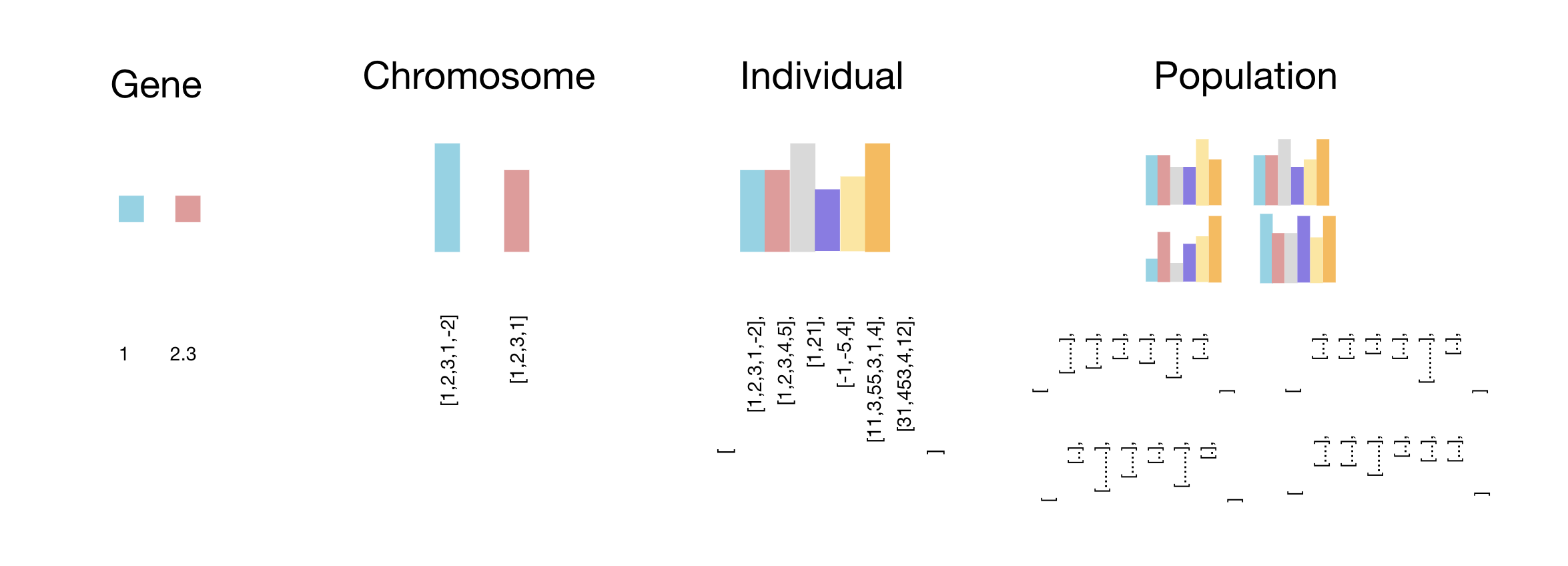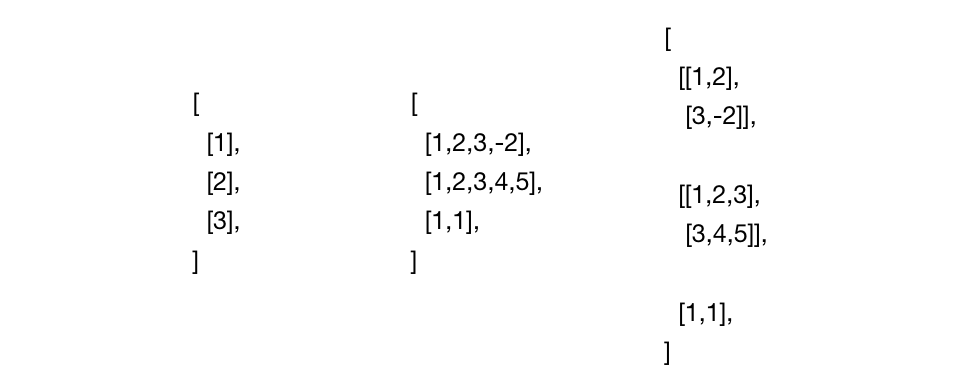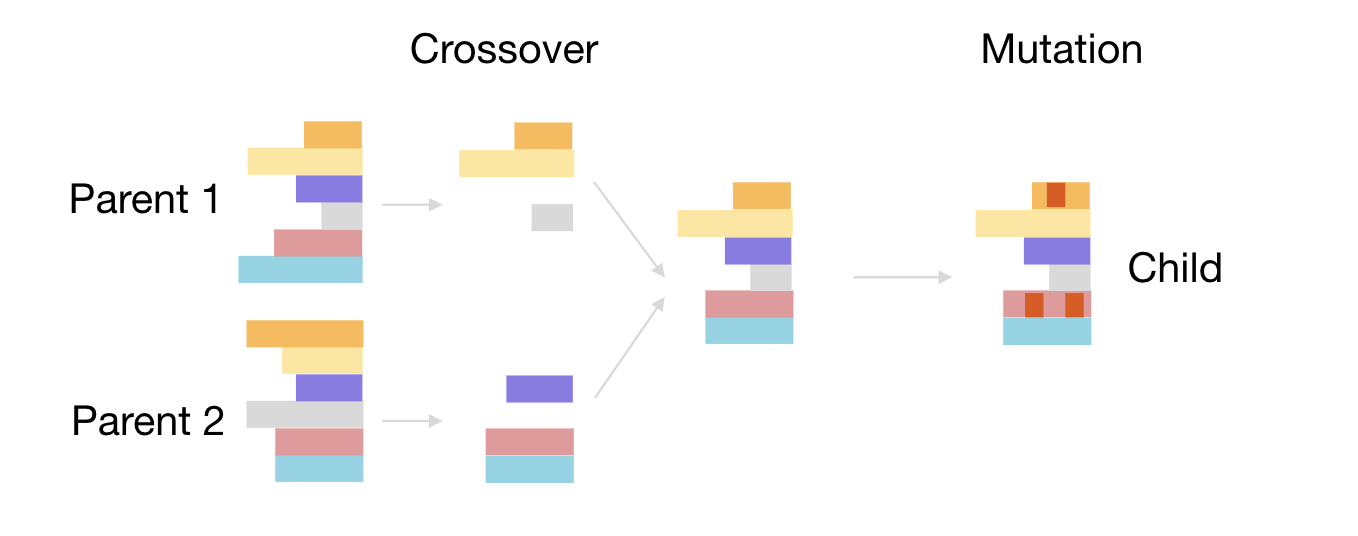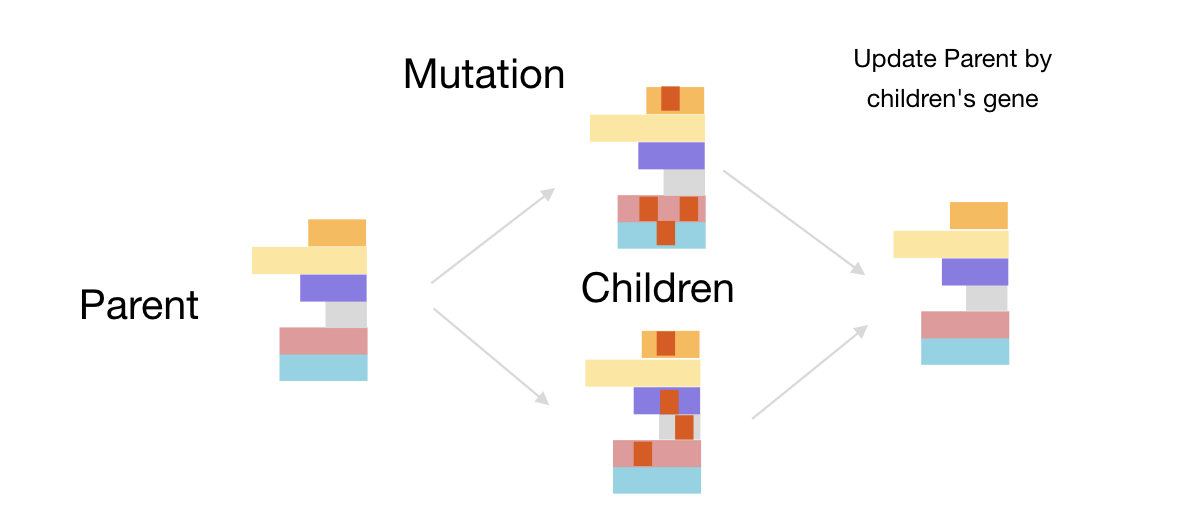Evolutionary Algorithms in Python
Project description
MEvo
MEvo is a evolutionary algorithm package, which implements Genetic Algorithm and Evolution Strategies Algorithms. It can be used to form an agent strategy or optimize math problems.
Quick look
Training a cartpole policy by using Genetic Algorithm.
import mevo
import gymnasium
import numpy as np
# define a fitness function to get fitness for every individual
def fitness_fn(ind: mevo.individuals.Individual, conf: dict) -> float:
ep_r = 0
env = gymnasium.make('CartPole-v1')
env.reset()
for _ in range(2):
s, _ = env.reset()
for _ in range(500): # in one episode
logits = ind.predict(s)
a = np.argmax(logits)
s, r, done, _, _ = env.step(a)
ep_r += r
if done:
break
return ep_r
# training
with mevo.GeneticAlgoNet(max_size=20, layer_size=[4, 8, 2], drop_rate=0.7, mutate_rate=0.5) as pop:
for generation in range(40):
pop.evolve(fitness_fn=fitness_fn)
print(f"generation={generation}, top_fitness={pop.top.fitness:.f2}")
After only 40 generations in a population (20 individuals), it gives a greate result. Use following code to visualize the learned policy.
# deploy the best individual
env = gymnasium.make('CartPole-v1', render_mode="human")
while True:
s, _ = env.reset()
while True: # in one episode
logits = pop.top.predict(s)
a = np.argmax(logits)
s, _, done = env.step(a)[:3]
if done:
break
What is MEvo
In the MEvo, the smallest data segment is Gene. A set of gene can be packed into a Chromosome. Chromosomes then formed an Individual. A Population consists of many individuals.
This is different from the classical Genetic Algorithm which their chromosome only consists of a 1D array. In other words, chromosome in the MEvo is n-D array with different shape.
Why making data shape varied?
Because we want to possibly evolve a neural network which has multiple layers in various shape.
MEvo has two different algorithm families.
- Genetic Algorithm family
- Evolution Strategy family
The Genetic Algorithm basically has two steps:
- crossover the chromosomes in a population
- mutate gene in new generation
The following image shows how crossover on two parents chromosomes, and how to mutate the new chromosome.
And MEvo's Evolution Strategy has different two steps:
- mutate gene (normal distribution) from one single chromosome
- update this chromosome by all mutated results
Parallel training
MEvo support parallel training. Simply set n_worker > 1 to unlock your machine power for training on multiple cores.
When n_worker=-1 then use all your cores.
Simply replace the pop definition by including n_worker from previous code.
# parallel training
if __name__ == "__main__":
with mevo.GeneticAlgoNet(max_size=20, layer_size=[4, 8, 2], n_worker=-1, drop_rate=0.7, mutate_rate=0.5) as pop:
for generation in range(40):
pop.evolve(fitness_fn=fitness_fn)
print(f"generation={generation}, top_fitness={pop.top.fitness:.2f}")
Note that the parallel code must be run under if __name__ == "__main__": scope,
otherwise a python multiprocessing err will occur.
Install
Using pip to install MEvo
pip3 install mevo
Methods and Parameters
MEvo support following populations:
- mevo.GeneticAlgoInt()
- mevo.GeneticAlgoFloat()
- mevo.GeneticAlgoOrder()
- mevo.GeneticAlgoNet()
- mevo.EvolutionStrategyNet()
A classical genetic algorithm problem
such as Travel Sales Problem (TSP) can be solved by following classical Populations:
- mevo.GeneticAlgoInt()
- mevo.GeneticAlgoFloat()
- mevo.GeneticAlgoOrder()
A Travel Sales Problem example using pop = mevo.GeneticAlgoOrder():
import mevo
import numpy as np
positions = [np.random.rand(2) for _ in range(20)]
def distance_fitness_fn(ind: mevo.individuals.Individual, conf: dict) -> float:
order = [c.data[0] for c in ind.chromosomes]
cost = 0
for i in range(len(order) - 1):
p1, p2 = positions[order[i]], positions[order[i + 1]]
cost += np.square(p1 - p2).sum()
fitness = -cost
return fitness
pop = mevo.GeneticAlgoOrder(
max_size=50,
chromo_size=len(positions),
drop_rate=0.3,
mutate_rate=0.01,
)
pop.run(fitness_fn=distance_fitness_fn, step=30)
An optimization problem example using pop = mevo.GeneticAlgoInt():
import mevo
import numpy as np
def wave_fitness_fn(ind: mevo.individuals.Individual, conf: dict) -> float:
binary = [c.data for c in ind.chromosomes]
c = np.concatenate(binary, axis=0)
a = 2 ** np.arange(len(c))[::-1]
decimal = c.dot(a)
x = decimal / float(2 ** len(c) - 1) * 5
o = np.sin(10 * x) * x + np.cos(2 * x) * x
return o
pop = mevo.GeneticAlgoInt(
max_size=20,
chromo_size=10,
drop_rate=0.3,
chromo_initializer=mevo.chromosomes.initializers.RandomInt(0, 2),
mutate_rate=0.01,
)
pop.run(step=20, fitness_fn=wave_fitness_fn)
Deep Net Evolution
For policy learning or Reinforcement learning alternative, the following two methods has their advantages.
- mevo.GeneticAlgoNet()
- mevo.EvolutionStrategyNet()
| Reinforcement Learning | MEvo | |
|---|---|---|
| Training | Has forward and backward propagation | Only has forward propagation, but need crossover or mutation operation (lighter than backpropagation) |
| Exploration | Needs carefully set explore policy | Different children setting automatically ensure the exploration |
| Memory needs | Can only keep one set of parameters | In each generation, must compute all children's parameters (parallel computing save time) |
| Network Size | Generally large and deep net | With a large scale exploration, a relatively small net can perform a good job |
A mevo.GeneticAlgoNet() example:
import mevo
import gymnasium
import numpy as np
def fitness_fn(ind: mevo.individuals.Individual, conf: dict) -> float:
ep_r = 0
env = gymnasium.make('Pendulum-v1')
env.reset(seed=conf["seed"])
for _ in range(2):
s, _ = env.reset()
for _ in range(150): # in one episode
logits = ind.predict(s)
a = np.tanh(logits) * 2
s, r, _, _, _ = env.step(a)
ep_r += r
return ep_r
def train():
with mevo.GeneticAlgoNet(
max_size=30,
layer_size=[3, 32, 1],
drop_rate=0.7,
mutate_rate=0.5,
n_worker=-1,
) as pop:
for ep in range(700):
pop.evolve(
fitness_fn=fitness_fn,
)
print(ep, pop.top.fitness)
return pop.top
def show(top):
env = gymnasium.make('Pendulum-v1', render_mode="human")
while True:
s, _ = env.reset()
for _ in range(200): # in one episode
logits = top.predict(s)
a = np.tanh(logits) * 2
s, _, _, _, _ = env.step(a)
if __name__ == "__main__":
top = train()
show(top)
A mevo.EvolutionStrategyNet() example:
import mevo
import gymnasium
import numpy as np
def fitness_fn(ind: mevo.individuals.EvolutionStrategyDense, conf: dict) -> float:
ep_r = 0
seed = conf["seed"]
index = conf["index"]
env = gymnasium.make('Pendulum-v1')
# ! must set seed and clone when using mevo.EvolutionStrategyNet()
env.reset(seed=conf["seed"])
c_ind = ind.clone_with_mutate(index, seed)
# ###############
for _ in range(2):
s, _ = env.reset()
for _ in range(100):
logits = c_ind.predict(s)
a = np.tanh(logits) * 2
s, r, _, _, _ = env.step(a)
ep_r += r
return ep_r
def train():
with mevo.EvolutionStrategyNet(
max_size=15,
layer_size=[3, 32, 1],
mutate_strength=0.05,
learning_rate=0.1,
n_worker=-1,
seed=2
) as pop:
for ep in range(700):
pop.evolve(fitness_fn=fitness_fn)
print(ep, pop.top.fitness)
return pop.top
def show(top):
env = gymnasium.make(
'Pendulum-v1',
render_mode="human"
)
while True:
s, _ = env.reset()
for _ in range(200): # in one episode
logits = top.predict(s)
a = np.tanh(logits) * 2
s, _, _, _, _ = env.step(a)
if __name__ == "__main__":
top = train()
show(top)
Project details
Release history Release notifications | RSS feed
Download files
Download the file for your platform. If you're not sure which to choose, learn more about installing packages.


















